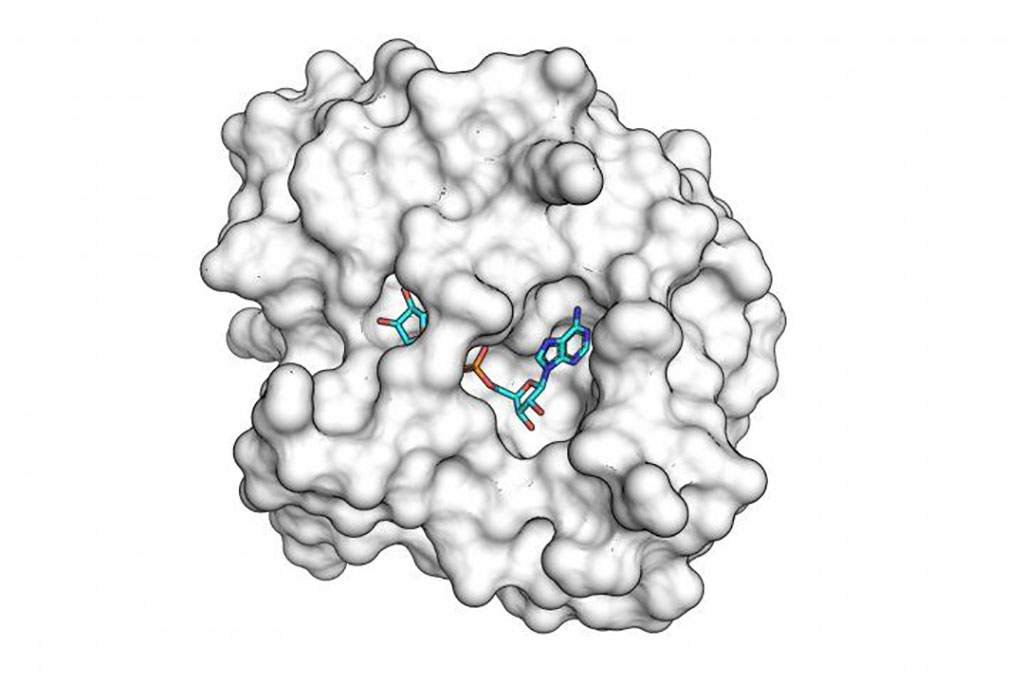Scientists Identify Key Chemical Building Blocks for Antiviral Drug Against SARS-CoV-2
|
By HospiMedica International staff writers Posted on 13 Jul 2020 |

Image: The SARS-CoV-2 macro domain protein bound to small molecule fragments that could be the basis of novel antiviral drugs (Photo courtesy of UCSF)
A team of scientists has identified key chemical building blocks for an eventual antiviral drug against SARS-CoV-2.
The new compounds identified by researchers from the UC San Francisco Quantitative Bioscience Institute Coronavirus Research Group (QCRG) in collaboration with Lawrence Berkeley National Laboratory (Berkeley Lab) and SLAC National Accelerator Laboratory (SLAC) bind to an enzyme produced by the virus, called the “macro domain,” which is known to be crucial for the virus’s ability to replicate in human cells. The study focused on poly (ADP-ribose) polymerases (PARPs), enzymes that play a major role in DNA repair and have been targeted by drugs to treat certain cancers.
The researchers set out to understand the molecular structure of the macro domain in order to identify small molecules with the right shape to jam the viral protein’s active site, the first step toward building an antiviral drug that could inhibit the virus’s spread by re-empowering PARPs’ protective tags. Using X-ray crystallography, they researchers grew crystals of isolated macro domain proteins, then bombarded these crystals with powerful X-rays, using the resulting diffraction patterns to infer a detailed picture of the macro domain’s atomic structure down to a resolution of nearly one angstrom, one millionth the diameter of a human hair. To identify small molecules capable of binding to the macro domain, the researchers used a technique called “fragment soaking” which involves creating hundreds of macro domain crystals, then using sound waves to manipulate candidate small molecules into the heart of each crystal and freezing them together in liquid nitrogen before returning to the X-ray light sources for further imaging. X-ray diffraction experiments revealed 13 small molecules, each about a third to a quarter the size of a normal drug molecule, that successfully bound to the macro domain, including four that bound to the enzyme’s active site.
Using the new information about what chemical structures can bind effectively to the macro domain’s active site, the researchers are now working with a virtual drug discovery platform to rapidly screen through half a billion potential drug-like molecules to find drug candidates that combine several of these potent chemical structures. According to the researchers, further work is needed to weld these potential active ingredients into a workable drug candidate, but the research represents a promising new frontier in the battle against the virus, particularly given uncertainties about the timing or ultimate efficacy of an eventual vaccine. The researchers have published their data directly online to accelerate global efforts to fight the coronavirus pandemic.
“The SARS-CoV-2 macro domain is not as well understood as the virus’s main protease or the spike proteins that other efforts are going after,” said James Fraser, PhD, an associate professor in the Department of Bioengineering and Therapeutic Sciences, based in the UCSF schools of Pharmacy and Medicine, who led the research effort as part of the UCSF QCRG Structural Biology Consortium. “We wanted to look where others aren’t looking as heavily and have succeeded in identifying some promising candidates to build drugs that could halt the virus’s ability to replicate and spread in the human body.”
The new compounds identified by researchers from the UC San Francisco Quantitative Bioscience Institute Coronavirus Research Group (QCRG) in collaboration with Lawrence Berkeley National Laboratory (Berkeley Lab) and SLAC National Accelerator Laboratory (SLAC) bind to an enzyme produced by the virus, called the “macro domain,” which is known to be crucial for the virus’s ability to replicate in human cells. The study focused on poly (ADP-ribose) polymerases (PARPs), enzymes that play a major role in DNA repair and have been targeted by drugs to treat certain cancers.
The researchers set out to understand the molecular structure of the macro domain in order to identify small molecules with the right shape to jam the viral protein’s active site, the first step toward building an antiviral drug that could inhibit the virus’s spread by re-empowering PARPs’ protective tags. Using X-ray crystallography, they researchers grew crystals of isolated macro domain proteins, then bombarded these crystals with powerful X-rays, using the resulting diffraction patterns to infer a detailed picture of the macro domain’s atomic structure down to a resolution of nearly one angstrom, one millionth the diameter of a human hair. To identify small molecules capable of binding to the macro domain, the researchers used a technique called “fragment soaking” which involves creating hundreds of macro domain crystals, then using sound waves to manipulate candidate small molecules into the heart of each crystal and freezing them together in liquid nitrogen before returning to the X-ray light sources for further imaging. X-ray diffraction experiments revealed 13 small molecules, each about a third to a quarter the size of a normal drug molecule, that successfully bound to the macro domain, including four that bound to the enzyme’s active site.
Using the new information about what chemical structures can bind effectively to the macro domain’s active site, the researchers are now working with a virtual drug discovery platform to rapidly screen through half a billion potential drug-like molecules to find drug candidates that combine several of these potent chemical structures. According to the researchers, further work is needed to weld these potential active ingredients into a workable drug candidate, but the research represents a promising new frontier in the battle against the virus, particularly given uncertainties about the timing or ultimate efficacy of an eventual vaccine. The researchers have published their data directly online to accelerate global efforts to fight the coronavirus pandemic.
“The SARS-CoV-2 macro domain is not as well understood as the virus’s main protease or the spike proteins that other efforts are going after,” said James Fraser, PhD, an associate professor in the Department of Bioengineering and Therapeutic Sciences, based in the UCSF schools of Pharmacy and Medicine, who led the research effort as part of the UCSF QCRG Structural Biology Consortium. “We wanted to look where others aren’t looking as heavily and have succeeded in identifying some promising candidates to build drugs that could halt the virus’s ability to replicate and spread in the human body.”
Latest COVID-19 News
- Low-Cost System Detects SARS-CoV-2 Virus in Hospital Air Using High-Tech Bubbles
- World's First Inhalable COVID-19 Vaccine Approved in China
- COVID-19 Vaccine Patch Fights SARS-CoV-2 Variants Better than Needles
- Blood Viscosity Testing Can Predict Risk of Death in Hospitalized COVID-19 Patients
- ‘Covid Computer’ Uses AI to Detect COVID-19 from Chest CT Scans
- MRI Lung-Imaging Technique Shows Cause of Long-COVID Symptoms
- Chest CT Scans of COVID-19 Patients Could Help Distinguish Between SARS-CoV-2 Variants
- Specialized MRI Detects Lung Abnormalities in Non-Hospitalized Long COVID Patients
- AI Algorithm Identifies Hospitalized Patients at Highest Risk of Dying From COVID-19
- Sweat Sensor Detects Key Biomarkers That Provide Early Warning of COVID-19 and Flu
- Study Assesses Impact of COVID-19 on Ventilation/Perfusion Scintigraphy
- CT Imaging Study Finds Vaccination Reduces Risk of COVID-19 Associated Pulmonary Embolism
- Third Day in Hospital a ‘Tipping Point’ in Severity of COVID-19 Pneumonia
- Longer Interval Between COVID-19 Vaccines Generates Up to Nine Times as Many Antibodies
- AI Model for Monitoring COVID-19 Predicts Mortality Within First 30 Days of Admission
- AI Predicts COVID Prognosis at Near-Expert Level Based Off CT Scans
Channels
Critical Care
view channel
CPR Guidelines Updated for Pediatric and Neonatal Emergency Care and Resuscitation
Cardiac arrest in infants and children remains a leading cause of pediatric emergencies, with more than 7,000 out-of-hospital and 20,000 in-hospital cardiac arrests occurring annually in the United States.... Read more
Ingestible Capsule Monitors Intestinal Inflammation
Acute mesenteric ischemia—a life-threatening condition caused by blocked blood flow to the intestines—remains difficult to diagnose early because its symptoms often mimic common digestive problems.... Read more
Wireless Implantable Sensor Enables Continuous Endoleak Monitoring
Endovascular aneurysm repair (EVAR) is a life-saving, minimally invasive treatment for abdominal aortic aneurysms—balloon-like bulges in the aorta that can rupture with fatal consequences.... Read more
Wearable Patch for Early Skin Cancer Detection to Reduce Unnecessary Biopsies
Skin cancer remains one of the most dangerous and common cancers worldwide, with early detection crucial for improving survival rates. Traditional diagnostic methods—visual inspections, imaging, and biopsies—can... Read moreSurgical Techniques
view channel
Robotic Assistant Delivers Ultra-Precision Injections with Rapid Setup Times
Age-related macular degeneration (AMD) is a leading cause of blindness worldwide, affecting nearly 200 million people, a figure expected to rise to 280 million by 2040. Current treatment involves doctors... Read more
Minimally Invasive Endoscopic Surgery Improves Severe Stroke Outcomes
Intracerebral hemorrhage, a type of stroke caused by bleeding deep within the brain, remains one of the most challenging neurological emergencies to treat. Accounting for about 15% of all strokes, it carries... Read morePatient Care
view channel
Revolutionary Automatic IV-Line Flushing Device to Enhance Infusion Care
More than 80% of in-hospital patients receive intravenous (IV) therapy. Every dose of IV medicine delivered in a small volume (<250 mL) infusion bag should be followed by subsequent flushing to ensure... Read more
VR Training Tool Combats Contamination of Portable Medical Equipment
Healthcare-associated infections (HAIs) impact one in every 31 patients, cause nearly 100,000 deaths each year, and cost USD 28.4 billion in direct medical expenses. Notably, up to 75% of these infections... Read more
Portable Biosensor Platform to Reduce Hospital-Acquired Infections
Approximately 4 million patients in the European Union acquire healthcare-associated infections (HAIs) or nosocomial infections each year, with around 37,000 deaths directly resulting from these infections,... Read moreFirst-Of-Its-Kind Portable Germicidal Light Technology Disinfects High-Touch Clinical Surfaces in Seconds
Reducing healthcare-acquired infections (HAIs) remains a pressing issue within global healthcare systems. In the United States alone, 1.7 million patients contract HAIs annually, leading to approximately... Read moreHealth IT
view channel
Printable Molecule-Selective Nanoparticles Enable Mass Production of Wearable Biosensors
The future of medicine is likely to focus on the personalization of healthcare—understanding exactly what an individual requires and delivering the appropriate combination of nutrients, metabolites, and... Read moreBusiness
view channel
Philips and Masimo Partner to Advance Patient Monitoring Measurement Technologies
Royal Philips (Amsterdam, Netherlands) and Masimo (Irvine, California, USA) have renewed their multi-year strategic collaboration, combining Philips’ expertise in patient monitoring with Masimo’s noninvasive... Read more
B. Braun Acquires Digital Microsurgery Company True Digital Surgery
The high-end microsurgery market in neurosurgery, spine, and ENT is undergoing a significant transformation. Traditional analog microscopes are giving way to digital exoscopes, which provide improved visualization,... Read more
CMEF 2025 to Promote Holistic and High-Quality Development of Medical and Health Industry
The 92nd China International Medical Equipment Fair (CMEF 2025) Autumn Exhibition is scheduled to be held from September 26 to 29 at the China Import and Export Fair Complex (Canton Fair Complex) in Guangzhou.... Read more















